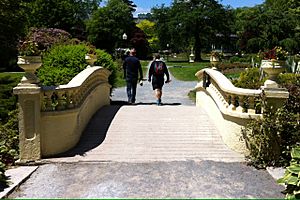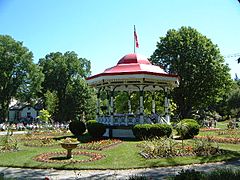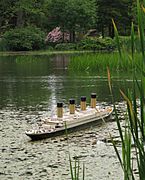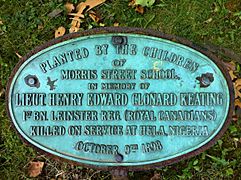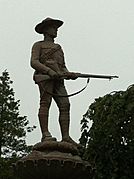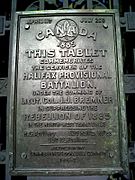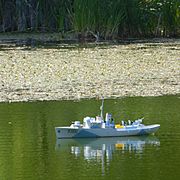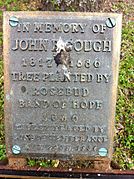Halifax Public Gardens facts for kids
Quick facts for kids Halifax Public Gardens |
|
|---|---|

Wrought-iron gates erected to honour the Halifax Provisional Battalion (1907)
|
|
| Type | City park |
| Location | Halifax, Nova Scotia |
| Area | 16 acres (6.5 ha) |
| Created | 1867 |
| Operated by | Halifax Regional Municipality |
| Status | Open all year |
| Public transit access | Halifax Transit |
| Official name: Halifax Public Gardens National Historic Site of Canada | |
| Designated: | 1984 |
| Type: | Municipally Registered Property |
| Designated: | 1991 |
The Halifax Public Gardens are beautiful public gardens that were officially opened in 1867. This was the same year that Canadian Confederation happened, when Canada became its own country! These gardens are in Halifax, Nova Scotia, on the Halifax Peninsula. They are close to the popular Spring Garden Road shopping area and across from Victoria Park. Because they are so special, the gardens were named a National Historic Site of Canada in 1984.
Exploring the Gardens
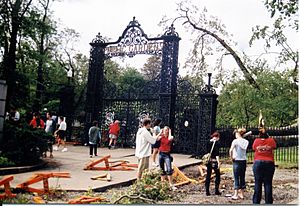
The Public Gardens cover 16 acres, which is about the size of 12 football fields! They are open every year from around May 1st to November 1st. The gardens are designed in a special way called "Victorian formal." This means they have very neat and organized flower beds, paths, and features. It's a very popular spot for taking photos, especially for weddings and school proms!
Inside the gardens, you'll find many interesting things. There are statues, lots of colorful flower beds, three fountains, and two stone bridges. You can also see three ponds (one big and two smaller ones). There's even a small building where you can buy snacks, which used to be called Horticultural Hall.
A cool feature of the gardens is the bandstand. During the summer, you can enjoy free public concerts there on Sunday afternoons. The gardens also host fun celebrations every year on Canada Day (July 1st) and Natal Day (the first Monday in August).
In the past, many people loved feeding the ducks that live in the gardens. However, it's now important not to feed them to keep them healthy and safe.
The Public Gardens faced a big challenge in 2003 when Hurricane Juan hit. Many trees were badly damaged or destroyed. This meant the gardens had to close early that year. But thanks to a lot of hard work and a radio telethon that raised $1 million, the gardens were restored! They reopened on Canada Day in 2004. Luckily, some of the very old trees survived the hurricane, like an American elm tree that has been there since the 1860s.
History of the Gardens
The Halifax Public Gardens officially started in 1874. This happened when two older gardens joined together. One was the Nova Scotia Horticultural Society Garden, which began in 1837. The other was a public park that opened in 1866.
In 1872, a person named Richard Power became the park's superintendent. He helped create the overall design of the gardens, making sure everything was balanced and organized. Over the years, he helped add many features. These included the bandstand (designed by architect Henry Busch), fountains, statues, and fancy wrought-iron gates. He also helped plant many annual flowers in beautiful patterns and improved Griffin's Pond, where water fowl live.
Because of their importance and beauty, the gardens were named a National Historic Site in 1984. They were also recognized as a special property by Nova Scotia in 1991.
Statues and Special Markers
As you walk through the Public Gardens, you'll see different plaques and statues. These are there to remember important people and events from history.
For example, there's a plaque for the Halifax Provisional Battalion. This group of soldiers served in a historical conflict called the North-West Rebellion. The beautiful wrought-iron gates at the entrance were also put up to honor this battalion. You might also see a plaque for Clonard Keating from Nova Scotia, who was a soldier.
There's also a statue of a soldier from the Canadian Mounted Rifles. This soldier fought in the Second Boer War, another historical conflict. The famous sculptor Hamilton MacCarthy created this statue. A tree was also planted to remember Charles Carroll Wood, who was the first Canadian soldier to be lost in the Boer War. You can also find a bridge that remembers Francis Joseph Fitzgerald from Nova Scotia. He was part of the Royal Northwest Mounted Police and was lost during a difficult patrol.
You'll also find two plaques that remember people who worked for social change in the 1930s. One flowerbed is dedicated to Frances Willard. She was a very important leader who worked to help women gain the right to vote in the U.S. (the 19th Amendment). She also led a group that encouraged people to live healthier lives. Another plaque marks a tree planted for John Bartholomew Gough. He was known for his speeches that inspired many people.
In 1887, the estate of a chief justice named Sir William Young donated three statues from Roman mythology to the gardens. These statues are of Ceres, the goddess of farming and growth; Flora, the goddess of flowers and spring; and Diana, the goddess of woodlands and wild animals. They are all located along a path called the Petit Allée. Six large decorative urns were also placed around the Bandstand.
Griffin Pond, where you can sometimes see a model of the Titanic, is named after a young Irishman named Lawrence Griffin. He was involved in a legal case long ago, and the pond was named to remember him.
-
The Royal Canadian Dragoons, Boer War Sculpture by Hamilton MacCarthy (1903).
-
The Halifax Provisional Battalion Plaque at the Main Gate (1907).
-
A model of HMCS Sackville in Griffin Pond.
-
The Frances Willard plaque (1939).
Images for kids


